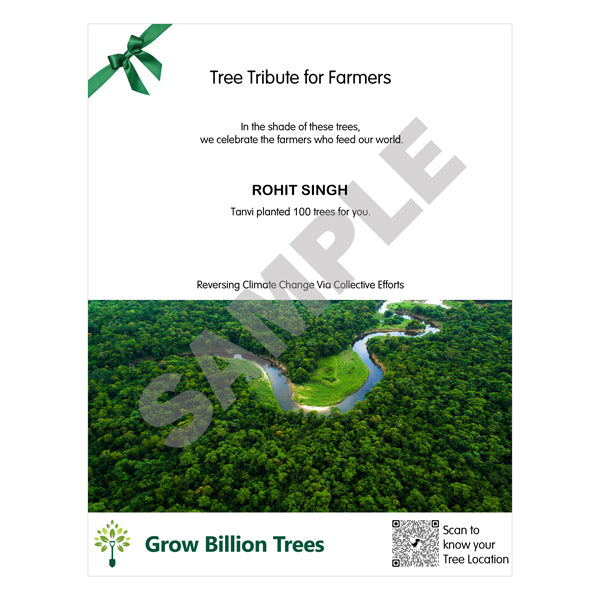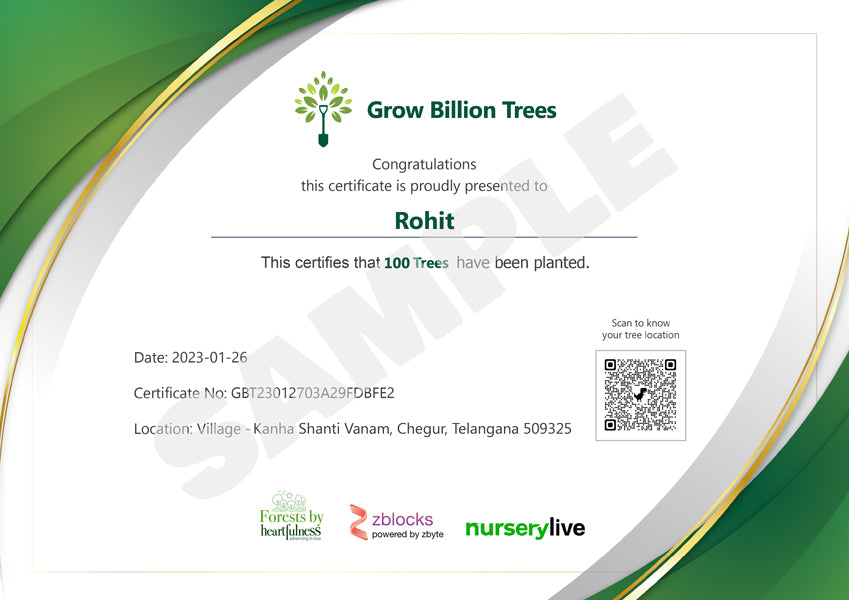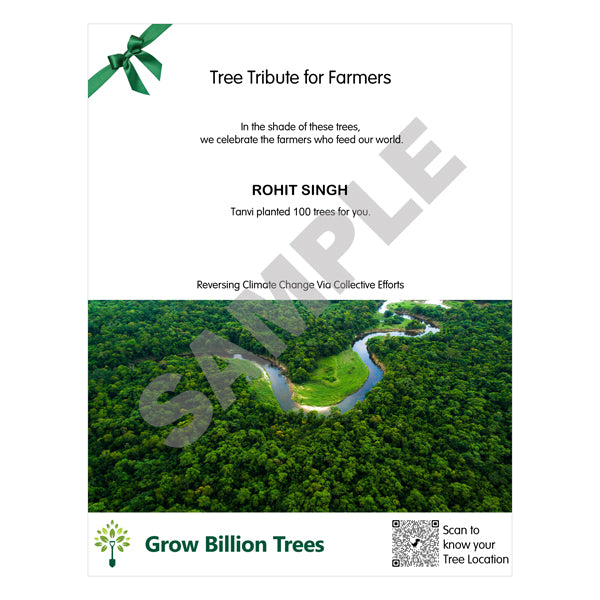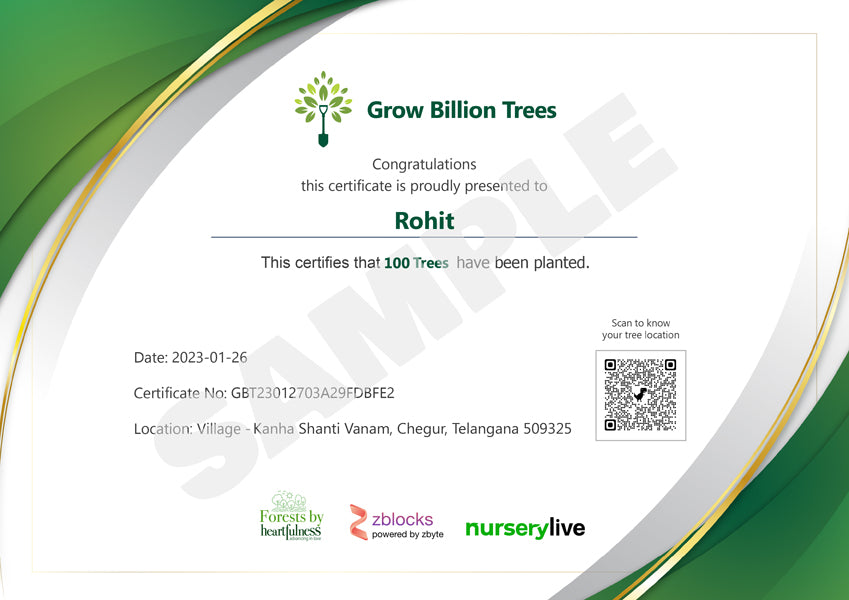


Description: Scope: Enhancement of Biodiversity Increase in Green Cover Empowering Women through livelihood generation Generation of Rural Employm Read more
Description:
Scope:
- Enhancement of Biodiversity
- Increase in Green Cover
- Empowering Women through livelihood generation
- Generation of Rural Employment
- Improvement of Wildlife Habitats
Tree Species:
The species of trees that are planted depend on the project, and they are chosen based on their native habitat in the corresponding ecological zone.
Why trees?
Celebrate their unwavering strength and resilience with a meaningful and impactful gift of a tree. It also has several benefits:
-
Symbolic of strength and growth: Trees are a symbolic representation of strength and growth, making them an ideal gift for your Dad. It not only acknowledges their fortitude but also contributes to a healthier planet and a better future for all.
-
Provide environmental benefits: Trees provide numerous benefits to the environment and communities, such as cleaning the air, conserving water, and providing shade. By gifting a tree, you are contributing to a healthier planet and a better future for all.
-
Sustainable and long-lasting: Unlike traditional gifts that may be used for a short period, trees are sustainable and can last for decades, providing ongoing benefits to the environment and communities.
-
Meaningful and impactful: Giving a tree as a gift is a meaningful and impactful gesture that allows you to show appreciation while making a positive impact. It is a symbol of hope, growth, and sustainability, and an excellent way to honor Your Dad.
Overall, gifting a tree to your Grandparents is a meaningful and impactful way to celebrate and honor the remarkable and loving Grandparents in your life. It is a symbol of hope, growth, and sustainability that acknowledges their strength and resilience while making a positive impact on the environment and the community.
Social Impact:
Tree plantation has a significant social impact, as it is a powerful way to uplift and empower Farmers, particularly in rural areas where they face many challenges. Trees provide multiple benefits such as food, fuel, and income, which can improve the lives of farmers and their families.
Tree plantation initiatives often involve rural households and cooperatives, where they can learn new skills, earn income, and create social networks.
Biodiversity Enhancement
Planting trees contributes to biodiversity enhancement by providing habitats for various species of flora and fauna, fostering ecosystem resilience and ecological balance.
Green Cover Expansion
Tree plantation initiatives aim to increase green cover, mitigating environmental degradation, soil erosion, and desertification while enhancing the aesthetic appeal of landscapes.
Empowerment of Women through Livelihood Generation
Tree planting offers opportunities for women's empowerment by providing avenues for income generation, skill development, and participation in decision-making processes.
Rural Employment Generation
Tree plantation projects generate employment opportunities for rural communities, particularly farmers, through activities such as nursery management, tree planting, and agroforestry practices.
Improvement of Wildlife Habitats
Trees serve as vital habitats for wildlife, supporting biodiversity conservation and the preservation of natural ecosystems, thus enhancing wildlife habitats.
Selection of Tree Species
The selection of tree species for plantation projects is based on their suitability to the ecological zone and their potential to provide environmental and socio-economic benefits to local communities.
Sustainable Agriculture Practices
Integrating trees into agricultural landscapes through agroforestry practices promotes sustainable agriculture, enhancing soil fertility, water retention, and crop productivity.
Community Participation in Tree Planting
Engaging local communities in tree planting initiatives fosters a sense of ownership, promotes social cohesion, and empowers individuals to actively contribute to environmental conservation efforts.
Capacity Building and Training
Tree plantation projects include capacity building and training programs to equip farmers with the knowledge and skills required for sustainable land management practices and tree care techniques.
Impact Assessment and Monitoring
Continuous monitoring and evaluation of tree plantation projects are conducted to assess their socio-economic and environmental impacts, ensuring effective implementation and outcomes.
FAQ
How does tree plantation contribute to biodiversity enhancement?
Tree plantation provides habitats for diverse species of flora and fauna, supporting biodiversity conservation and ecosystem resilience.
What are the benefits of increasing green cover through tree plantation?
Increasing green cover helps mitigate environmental degradation, soil erosion, and desertification while enhancing the aesthetic appeal of landscapes.
How does tree planting empower women through livelihood generation?
Tree planting offers women opportunities for income generation, skill development, and participation in decision-making processes, contributing to their empowerment.
How do tree plantation projects generate rural employment?
Tree plantation projects create employment opportunities for rural communities, particularly farmers, through activities such as nursery management and agroforestry practices.
What role do trees play in improving wildlife habitats?
Trees serve as vital habitats for wildlife, supporting biodiversity conservation and the preservation of natural ecosystems, thus enhancing wildlife habitats.
How are tree species selected for plantation projects?
Tree species are selected based on their suitability to the ecological zone and their potential to provide environmental and socio-economic benefits to local communities.
Why is community participation important in tree planting initiatives?
Community participation fosters a sense of ownership, promotes social cohesion, and empowers individuals to actively contribute to environmental conservation efforts.
What kind of training is provided to farmers in tree plantation projects?
Farmers receive training in sustainable land management practices, tree care techniques, and agroforestry methods to ensure the success of tree plantation projects.
How are the impacts of tree plantation projects assessed and monitored?
Continuous monitoring and evaluation are conducted to assess the socio-economic and environmental impacts of tree plantation projects, ensuring effective implementation and outcomes.
What are the long-term goals of tree plantation initiatives for farmers?
The long-term goals include sustainable agriculture practices, improved livelihoods, enhanced environmental conservation, and resilient rural communities.



